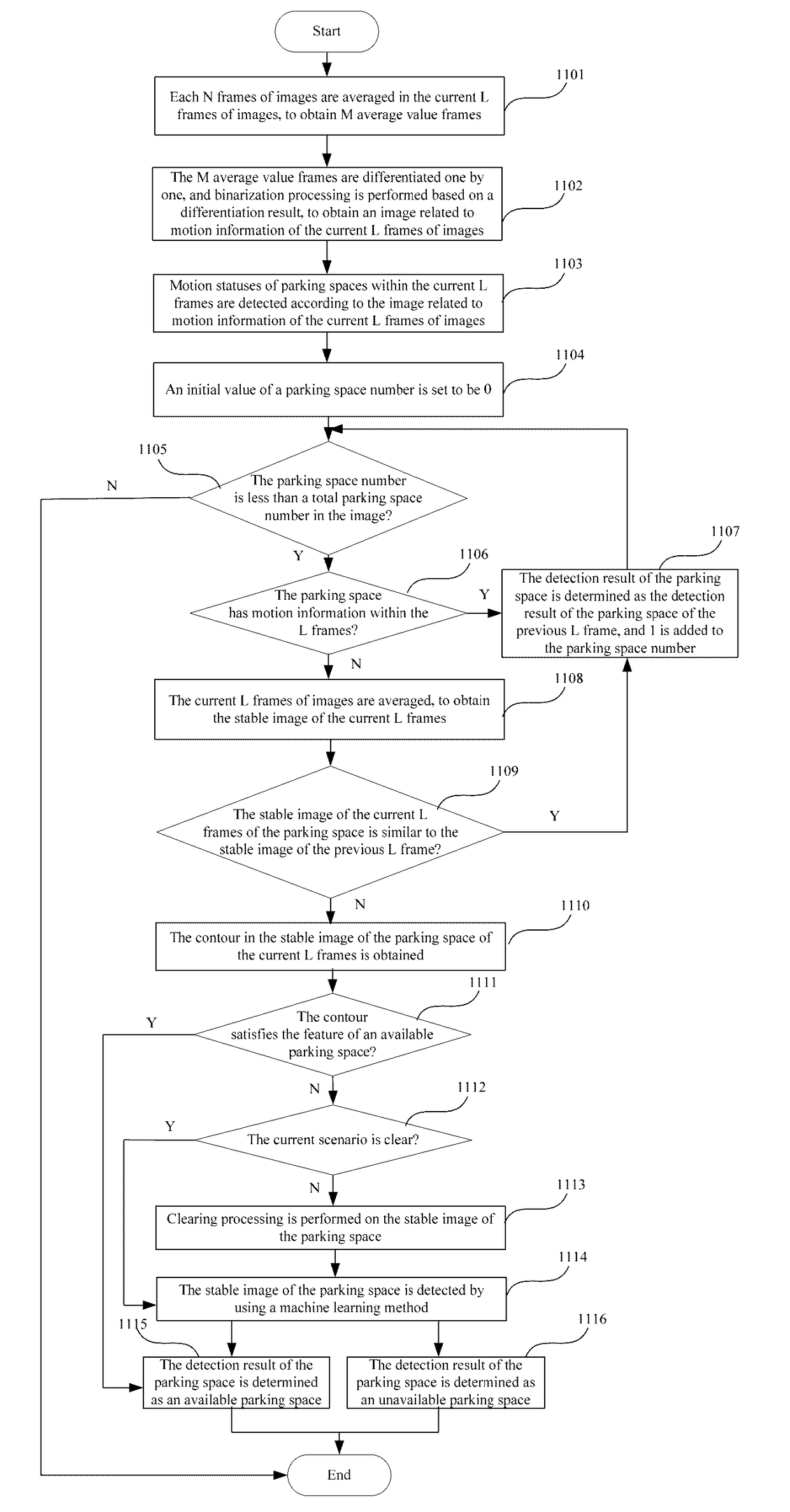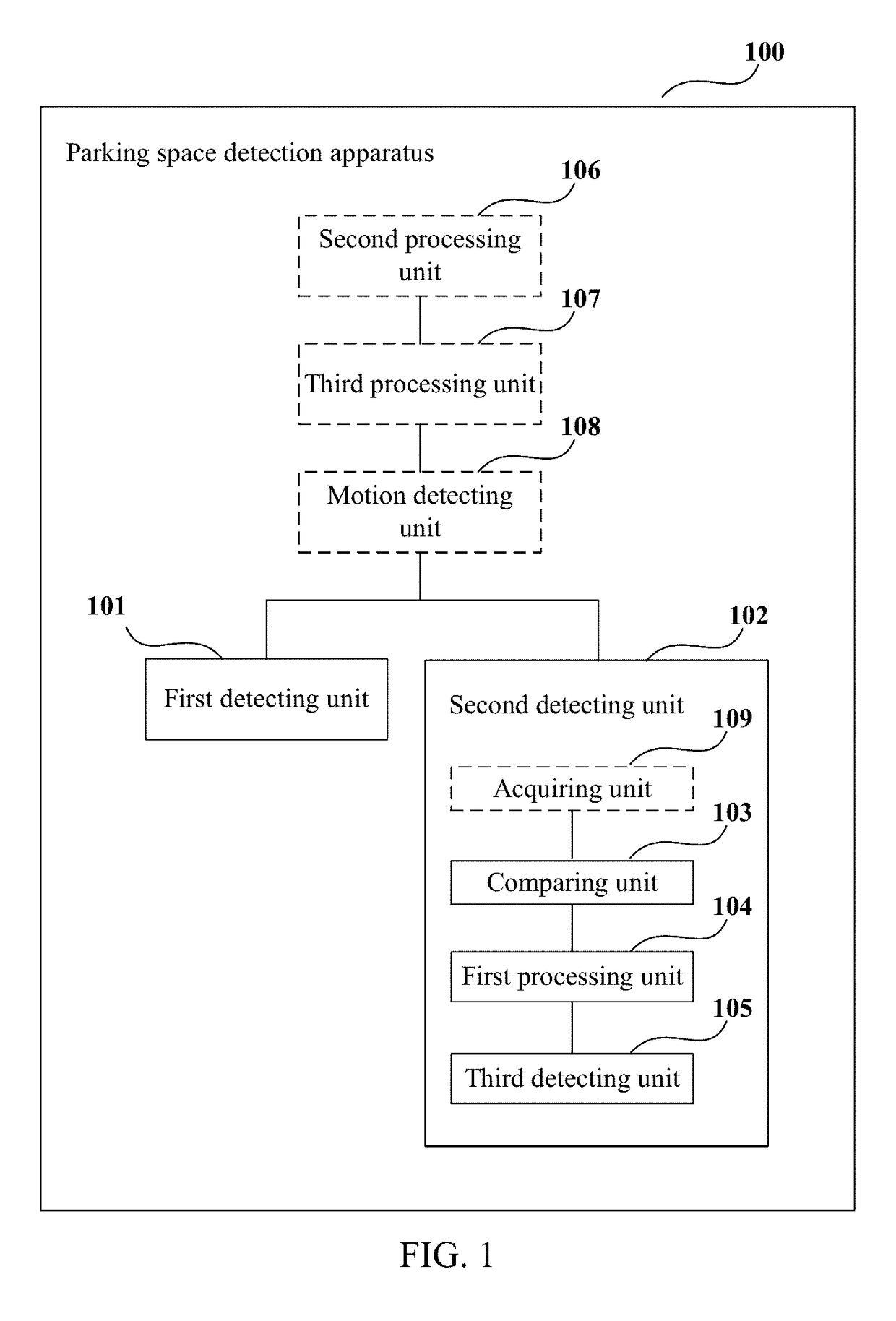Parking space detection apparatus and method, electronic apparatus
a technology of detection apparatus and space, applied in the field of information technology, can solve the problems of inability to collect such real-time information manually, jammed regions, and parking problems, and achieve the effects of ensuring stability of detection results, reducing processing costs, and reducing processing costs
- Summary
- Abstract
- Description
- Claims
- Application Information
AI Technical Summary
Benefits of technology
Problems solved by technology
Method used
Image
Examples
embodiment 1
[0033]FIG. 1 is a schematic diagram of the parking space detection apparatus of Embodiment 1 of the present disclosure. As shown in FIG. 1, the parking space detection apparatus 100 detects or performs monitoring of videos of a parking lot one by one taking images of a predefined number of frames as a unit, the apparatus including:[0034]a first detecting unit 101 configured to, in detecting each image of a predefined number of frames, for a parking space having motion information within a current predefined number of frames, determine a detection result of the parking space as a detection result of the parking space of a previous predefined number of frames; and[0035]a second detecting unit 102 configured to, in detecting each image of a predefined number of frames, detect images one by one of a parking space having no motion information within the current predefined number of frames;[0036]wherein, the second detecting unit 102 includes:[0037]a comparing unit 103 configured to, in d...
embodiment 2
[0073]An embodiment of the present disclosure further provides electronic equipment. FIG. 7 is a schematic diagram of a structure of the electronic equipment of Embodiment 2 of the present disclosure. As shown in FIG. 7, the electronic equipment 700 includes a parking space detection apparatus 701. In this embodiment, a structure and functions of the parking space detection apparatus 701 are identical to those contained in Embodiment 1, and shall not be described herein any further.
[0074]FIG. 8 is a block diagram of a systematic structure of the electronic equipment of Embodiment 2 of the present disclosure. As shown in FIG. 8, the electronic equipment 800 may include a central processing unit 801 (or computer) and a memory 802, the memory 802 being coupled to the central processing unit 801. This figure is illustrative only, and other types of structures may also be used, to supplement or replace this structure and achieve telecommunications function or other functions.
[0075]As sho...
embodiment 3
[0084]An embodiment of the present disclosure further provides a parking space detection method, which detects monitoring videos of a parking lot one by one taking images of a predefined number of frames as a unit, and which corresponds to the parking space detection apparatus of Embodiment 1. FIG. 9 is a flowchart of the parking space detection method of Embodiment 3 of the present disclosure. As shown in FIG. 9, the method includes:[0085]Step 901: in detecting each image of a predefined number of frames, for a parking space having motion information within a current predefined number of frames, a detection result of the parking space is determined as a detection result of the parking space of a previous predefined number of frames; and[0086]Step 902: in detecting each images of a predefined number of frames, images are detected one by one of a parking space having no motion information within the current predefined number of frames.
[0087]FIG. 10 is a flowchart of step 902 in FIG. ...
PUM
 Login to View More
Login to View More Abstract
Description
Claims
Application Information
 Login to View More
Login to View More - R&D
- Intellectual Property
- Life Sciences
- Materials
- Tech Scout
- Unparalleled Data Quality
- Higher Quality Content
- 60% Fewer Hallucinations
Browse by: Latest US Patents, China's latest patents, Technical Efficacy Thesaurus, Application Domain, Technology Topic, Popular Technical Reports.
© 2025 PatSnap. All rights reserved.Legal|Privacy policy|Modern Slavery Act Transparency Statement|Sitemap|About US| Contact US: help@patsnap.com



